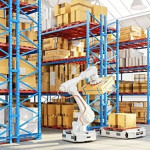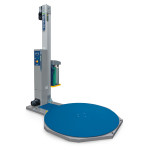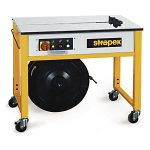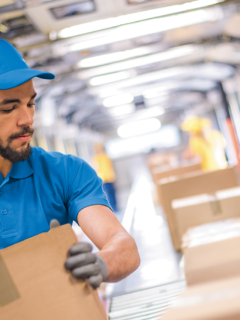According to the latest estimates from LogisticsIQ, the market for automated logistics solutions could exceed $44 billion by 2028.
And as the years go by, warehouse automation is incorporating more and more advanced technologies to meet the logistics sector’s growing demands for both efficiency and quality.
Here we take a look at the latest in these innovations, their benefits and emerging trends.
What are the benefits of warehouse automation?
All industries, from e-commerce to retail, are using automated systems to manage their logistics activities.
Businesses are increasingly turning to these technologies for the following benefits:
- Increased speed and productivity. Automation enables you to meet the increasing demands of customers, who want both faster deliveries and optimal service quality.
- Fewer logistical errors. Machines make fewer errors than humans, especially when it comes to order fulfilment and inventory management, increasing customer satisfaction and company profitability.
- Flexibility in the warehouse. Technology helps logisticians manage order peaks and variations in logistics flows.
- Reduced labour costs. Technology makes it possible to solve the problem of recruiting logistics operators by reducing the need for labour.
What types of warehouse automation are available today?
All stages of the supply chain are now affected by automated systems, enabling overall supply chain optimisation.
Here are some examples of how logistics departments are using them.
Automated information gathering
It is now possible to automate the collection of information in the logistics warehouse without the need for human intervention.
These types of automation are based on :
- Machine Vision, i.e. cameras that record behaviour and movements, e.g. to track an operator’s entire route and ensure quality control during order preparation.
- Internet of Things (IoT) sensors: for example, a parcel can be automatically checked on a conveyor belt, with photography, labelling, weight control, etc.
This information can be used to control the physical process (deviation zone, return, etc.) and traceability, to relay information to the customer or customer service. - Drones, which can be used to carry out a logistics inventory by scanning all products in the warehouse space.
Automated picking
The picking phase in your warehouse can also be automated thanks to :
- An automated storage system for boxes. The boxes are connected to conveyor belts that automatically transport the products to the order preparation area
- Robotic arms that can retrieve products from one aisle to another, thus limiting the number of movements required by the pickers.

Automation of internal flows
Thanks to the automation of logistics, warehouses can also speed up the movement of goods within the warehouse, without the need for human intervention.
This can be achieved by :
- Box or pallet conveyors, which transport products from one area of the warehouse to another
- Automated guided vehicles, also known as AGVs
- Stacking cranes, i.e. handling equipment that moves automatically lengthwise and heightwise in the warehouse aisles
- Mobile robots, 100% autonomous and automated
- Pallet shuttles, i.e. warehouse systems with motorised shuttles
Automated loading and unloading of vehicles
There are semi-automated systems for loading and unloading goods from lorries at the storage docks.
Note that these systems still require human intervention for fine control, although it is minimal.
Automation of product packaging
Many warehouses are introducing machines to automate order preparation.
These machines reduce the effort of operators in repetitive tasks and increase the rate of packing.
They can include :
- Automatic or semi-automatic strapping machines
- Automatic or semi-automatic stretch wrapping machines, programmable according to palletising needs
Total automation of warehouses
Some companies have chosen to fully automate their warehouses. These warehouses are so-called dark warehouses: spaces where no humans work and where all operations are automated.
They are called dark warehouses because no lighting is needed – because machines don’t need light to work!
The prerequisites for setting up automated systems
Are you interested in installing automated systems in your warehouse? Here are the three prerequisites you need to incorporate into your project to make it a success.
Conduct a feasibility study
The first step is to determine whether your warehouse would really benefit from automating your processes.
These technologies require significant investment, so you need to make sure you only use them if they can give you a real return on investment,
rather than just a trend.
Determine which logistics solutions can be automated. These are generally the ones that are repetitive and constant and where the risk of errors is very high.
The real needs of your warehouse should guide the implementation of your automated systems.
Implementing a Warehouse Management System (WMS)
The implementation of a Warehouse Management System (WMS ) is crucial for any warehouse automation project.
This type of warehouse management software allows you to monitor your logistics operations in real time and coordinate the various automated installations.
It must be integrated with the automation systems that you put in place.
Train your logistics teams
In most warehouses, machines cannot completely replace people – and is that even desirable? It is therefore necessary to train your teams in these automated processes,
to make them aware of their own roles in relation to the technology and to implement a real change management throughout the project.
What does the future hold for warehouse automation?
Automated logistics management should continue to evolve over time, with increasingly advanced technologies.
Artificial intelligence to automate warehouses
Many logistics software packages have already started to integrate artificial intelligence to help logisticians achieve even higher levels of automation.
As Jos DE VUYST, CEO of Stow Group, explains in our guide “What will the warehouse of the future look like?:
“Many of today’s robotic programmes contain a layer of artificial intelligence, based on machine learning.
Eventually, these robots will know what tasks to perform, without a human even having to ask them.
And we can imagine that if the technology goes so far as to integrate deep learning, the robots could even become 100% autonomous and perform their own maintenance actions.”
Collecting data on a single platform
The second development predicted for the future of logistics automation is a platform that would bring together all the data associated with a product’s order path,
from the moment it arrives at your warehouse until it is delivered to the customer.
Baudouin DE MARTENE, pre-sales consultant at Reflex (HARDIS GROUP), explains:
“Today, we see logistics chains where data is tracked from one warehouse to another, with this data circulating between different logistics IT systems.
WMS work with mechanisation technologies, automation, transport management systems… In short: no solution works alone anymore.
This is why, in the long term, logistics must become part of a network that can be shared by different actors in the sector.
We are already talking about the physical Internet in logistics: this picture speaks for itself.
It is this coordination that will allow us to meet the challenges of cost, ecology and stock productivity.”
Logistics predictions at the centre of automation
Thanks to IoT, logistics robots and automated systems, tomorrow’s logistics experts will have more opportunities than ever to gather data about their supply chain.
And the more data they have at their disposal, the more they will be able to predict actions (on marketing needs, inventory, sales, production, etc.)
















